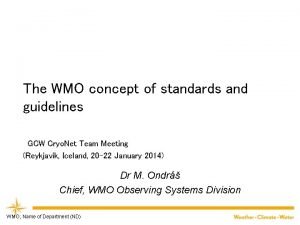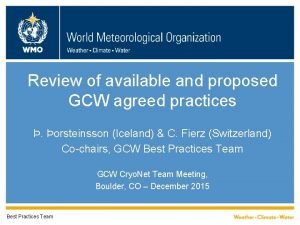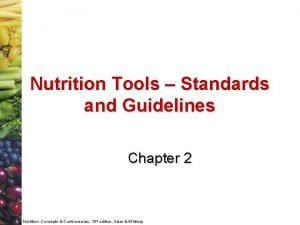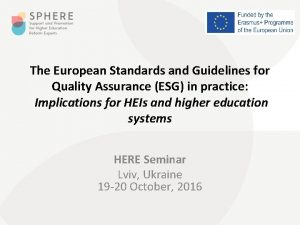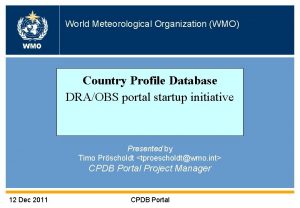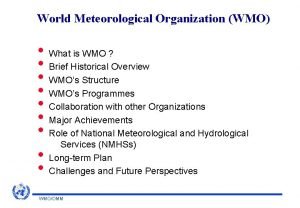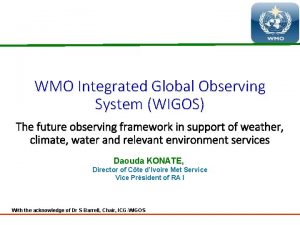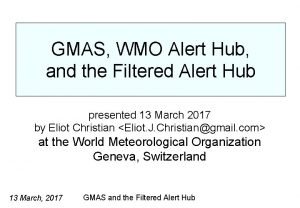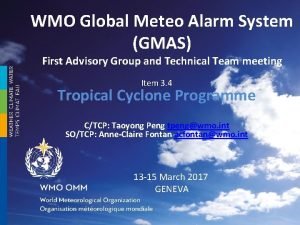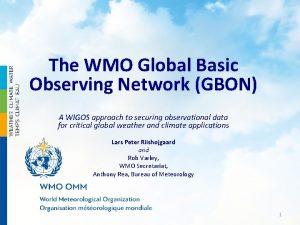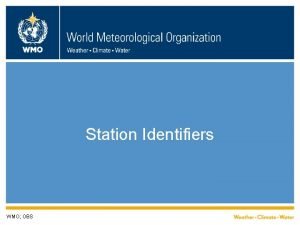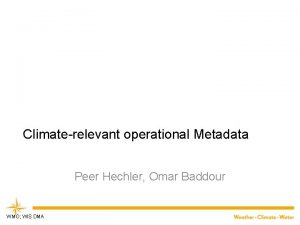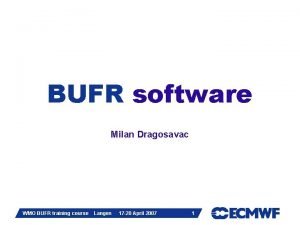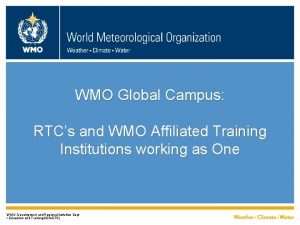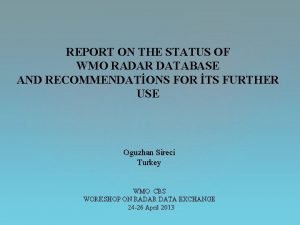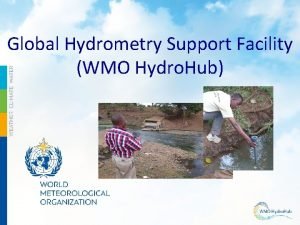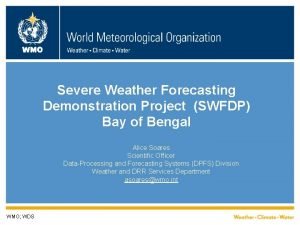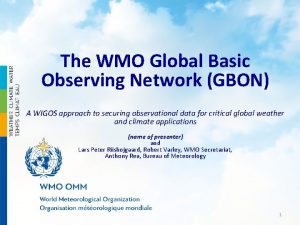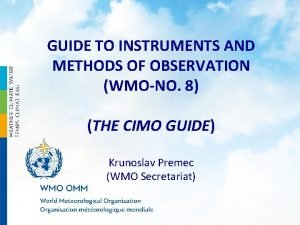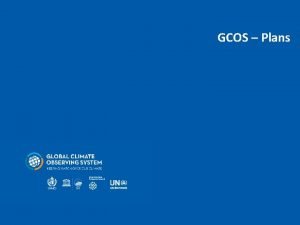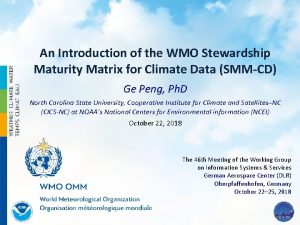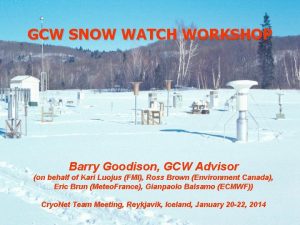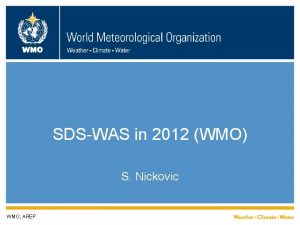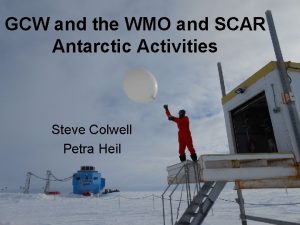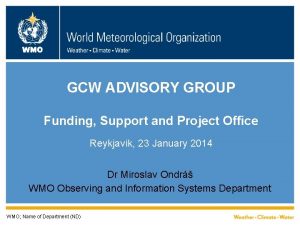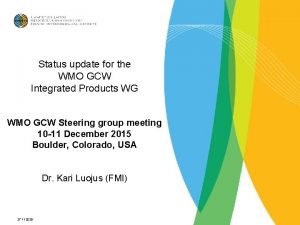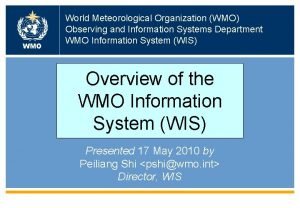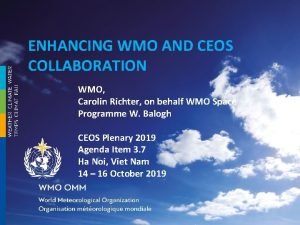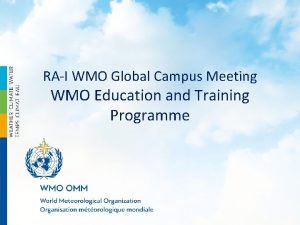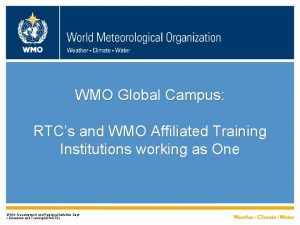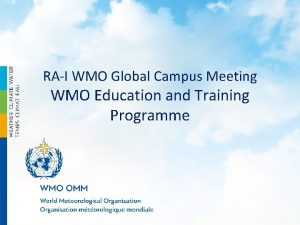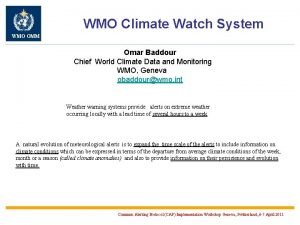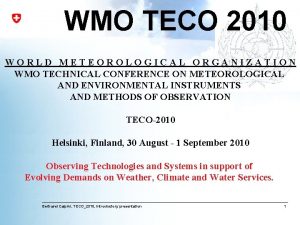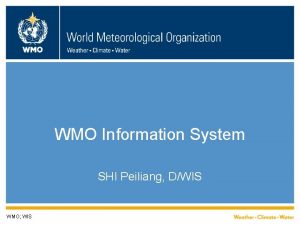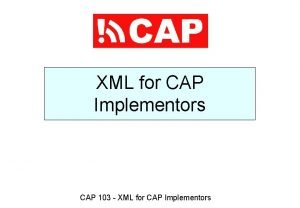The WMO concept of standards and guidelines GCW























- Slides: 23

The WMO concept of standards and guidelines GCW Cryo. Net Team Meeting (Reykjavik, Iceland, 20 -22 January 2014) Dr M. Ondráš Chief, WMO Observing Systems Division WMO; Name of Department (ND)

Outline 1. About WMO 2. Standardization within WMO and relevance to GCW 3. Recommendations for standardization in Cryo. Net

WMO Organigram

WMO Convention (Part II, Article 2, Purposes) (a) To facilitate worldwide cooperation in the establishment of networks of stations for the making of meteorological observations as well as hydrological and other geophysical observations related to meteorology, and…; (b) To promote the establishment and maintenance of systems for the rapid exchange of meteorological and related information; (c) To promote standardization of meteorological and related observations and to ensure the uniform publication of observations and statistics; (d) …

General Regulation of WMO ( Annex III, Structure and TOR of the Technical Commissions) I. Basic Commissions • CBS – (A) • CIMO – (A) • CHy – (A) • CAS – (B) II. Applications Commissions • CAe. M – (C) • CAg. M - (C) • JCOMM - (C) • CCl - (C) (A) Basic operations and facilities (C) Applications to economic and (B) Research in Atmospheric sciences social activities Develop, for consideration by the Executive Council and Congress, proposed international standards for methods, procedures, techniques and practices in meteorology and operational hydrology including, in particular, the relevant parts of the Technical Regulations, guides and manuals.

What is a standard? v v There are many definitions of a 'standard'. Very generally, a standard might simply be defined as 'a set of rules for ensuring quality'. ISO/IEC Guide 2: 2004, definition 3. 2 defines a standard as: q document established by consensus and approved by a recognized body that provides for common and repeated use, rules, guidelines or characteristics for activities or their results, aimed at the achievement of the optimum degree of order in a given context. NOTE: Standards should be based on the consolidated results of science, technology and experience, and aimed at the promotion of optimum community benefits.

WMO as a standards organization v Working arrangements between ISO and WMO: q q ISO has recognized WMO as an international standardization body through ISO Council Resolution 43/2007 WMO is listed on the web as a standard-making organization, e. g. : http: //en. wikipedia. org/wiki/List_of_technical_standard_organisations

WMO Technical Regulations - History § § Pre-WMO (1873 -1951): § IMO created some Technical Resolutions that established the basis for future regulation and standardization WMO: § Cg-I (1951): § § Interim arrangements – Res 4 (Cg-I) extended the validity of the IMO technical resolutions until the preparation of the new WMO TRs 1 6 5 9 Cg-II (1955): § § Res 17 (Cg-II) – Defined the WMO Technical Regulations and the terms “standard meteorological practices and procedures” and “recommended meteorological practices and procedures” Res 18 (Cg-II) – Definition of the Guides of WMO still valid and available in WMO-No. 508) Res 19 (Cg-II) – Adopted the Technical Regulations (Vol I and Vol II) for implementation as of 1 July 1956 Res 20 (Cg-II) – Notification of deviations from standard meteorological practices and procedures (“standards”) further amended by Cg-III 1955 to include notification of compliance.

WMO Technical Regulations - History q Cg-VI (1971): § Introduced the concept of Manuals as Annexes to the Technical Regulations; Manual on the GTS became Annex III; the global aspects of Annexes consist standards and recommendations (same status as the TRs); approval of amendments by the EC § Adopted Volume III – Operational Hydrology q Cg-VII (1975): § Alignment of the TRs with the World Weather Watch q After Cg-X (1987): § Edition 1988 was published and remained valid with some Supplements until Cg-XVI in 2011 q EC-60 (2008): § Approved the Working Arrangements between ISO and WMO q 2 2 1 0 Cg-XVI (2011): § Res 45: called for revision of the regulatory documents in a systematic manner and ensure that the published versions of the regulatory documents can be used as reference documentation; adopted Volume IV, Quality

WMO Technical Regulations – Composition v Types of regulations - SPPs and RPPs defined by Congress (Res 17 (Cg-II)), currently included in the General Provisions of TRs and Introduction part of Manuals Standard practices and procedures Recommended practices and procedures necessary for Members to follow or implement desirable for Members to follow or implement distinguished by the use of the term shall distinguished by the use of the term should status of requirements status of recommendations Members shall do their utmost to implement Members urged to comply with Article 9(b) of the Convention (report of the inability to implement a decision) is applicable Article 9(b) of the Convention is not applicable GR 128 (notification of non-compliance within GR 128 is not applicable 90 days) is applicable test footer 10

Regulations Prescriptive WMO Technical Regulations - Composition “Shall” and “Should” have specific (Vol 1 – 4) meaning TRs Manuals Descriptive Non. Regulations (Annex 1 – 8) Guides “Shall” and “Should” have ordinary meaning Other reference docs (e. g. , TR Manuals Vol II, WMO-No. 9, Guidelines, etc. ) • Basic SARPs (definitive) • Mostly requirement-driven • Approval by Congress (in principle) • Relatively Conservative • More detailed SARPs (procedures and specifications) • Mostly technology-driven • Approval delegated to EC • Relatively Dynamic • Procedures and practices • Implementation guidance • Explanations • Examples, good practice • Flexible updates

WMO Technical Regulations - Composition v WMO Technical Regulations – Basic Documents No. 2, WMO-No. 49: q q q Volume I General Meteorological Standards and Recommended Practices Volume II Meteorological Service for International Air Navigation Volume III Hydrology q Volume IV Quality Management

WMO Technical Regulations - Composition v WMO Technical Regulations - Basic Documents No. 2, WMO-No. 49 - Annexes: q q q q q Annex I International Cloud Atlas (WMO-No. 407), Volume I – Manual on the Observation of Clouds and Other Meteors, (in part) Annex II Manual on Codes (WMO-No. 306), Volume I. 1 (Part A - Alphanumeric Codes); Volume I. 2 (Part B - Binary Codes, Part C - Common Features to Binary and Alphanumeric Codes) Annex IIIManual on the Global Telecommunication System (WMONo. 386), Volume I Annex IV Manual on the Global Data-processing and Forecasting System (WMO-No. 485), Volume I Annex V Manual on the Global Observing System (WMO-No. 544), Volume I Annex VI Manual on Marine Meteorological Services (WMO-No. 558), Volume I Annex VII Manual on the WMO Information System (WMO-No. 1060) Annex VIII Manual on the Implementation of Education and Training Standards in Meteorology and Hydrology (WMO-No. 1083) Annex IX WIGOS Manual (for consideration by Cg-17 in 2015)

Manual on the Global Observing System, WMO-No. 544 § Part I. General Principles Regarding the Organization, Design and Implementation of the Global Observing System § Part II. Requirements for Observational Data - WMO Rolling Review of Requirements § Part III. & Part IV Surface- and Space-based Subsystems: Composition & Implementation of Elements § Part V. Quality Control http: //www. wmo. int/pages/prog/www/OSY/Manuals_GOS. html

Draft structure of the WIGOS sections in the WMO Technical Regulations, WMONo. 49 (as decided by EC-65 in May 2013) § VOLUME I – General Standards and Recommended Practices § PART I. WMO Integrated Global Observing System (WIGOS) I. 1 Introduction I. 2 Common attributes of component systems I. 3 Common attributes specific to the surface-based sub-system of WIGOS I. 4 Common attributes specific to the space-based sub-system of WIGOS I. 5 Observing component of the Global Atmosphere Watch (GAW) I. 6 Observing component of the Global Cryosphere Watch (GCW) I. 7 Global Observing System (GOS) of WWW I. 8 WMO Hydrological Observing System (ref. Vol. III)

WIGOS Manual 1. Introduction to WIGOS 2. Common attributes of component systems 3. Common attributes specific to the surface-based subsystem of WIGOS 4. Common attributes specific to the space-based subsystem of WIGOS 5. Observing component of the global atmosphere watch (GAW) 6. Observing component of the global cryosphere watch (GCW) 7. Global observing system (GOS) of www 8. Wmo hydrological observing system

WIGOS Manual – Section 5 “GAW” 5. 1 Requirements 5. 2 Design, planning and evolution 5. 2. 1 Review of observational user requirements 5. 2. 2 Review of current and planned observing systems capabilities 5. 2. 3 Monitoring observing systems implementation 5. 3 Instrumentation and Methods of Observation 5. 3. 1 General Requirements of Instruments/Sensor 5. 3. 2 General Requirements of (Observing Systems) 5. 3. 3 Calibration and Traceability 5. 3. 4 Data and Metadata Representation and Format 5. 3. 5 General Requirements of GAW Stations 5. 3. 6 Methods of Observation 5. 4 Operations 5. 4. 1 Observing Practices 5. 4. 2 Quality Assurance/Control/Monitoring/E valuation 5. 4. 3 Data and Metadata Reporting 5. 4. 4 Incident Management (Control) 5. 4. 5 Change Management – need a cross reference to 5. 6. 2. 2 5. 4. 6 Maintenance (Preventative, Corrective and Adaptive) 5. 4. 7 Calibration procedures 5. 5 Observational Metadata 5. 5. 1 Instrument metadata 5. 5. 2 Site/Station/Platform metadata 5. 5. 3 Network metadata 5. 5. 4 Quality metadata 5. 5. 5 Interpretation metadata 5. 5. 6 Maintenance metadata 5. 6 Quality Management 5. 7 Capacity Development

WMO Technical Regulations Implementation § Through the TRs, WMO has established an international (global) regulatory framework enabling a harmonized and standardized conduct of the meteorological, hydrological and climatological activities; § TRs require all Members to align their national practices with specified set of standard and recommended practices and procedures; § The enforcement of the international regulatory framework should be achieved through the “translation” of the TRs into appropriate national legislation and regulation, which each Member establishes for the conduct of meteorological, hydrological and climatological activities; § WMO Convention (e. g. , Article 9) and General Regulations (e. g. , GR 128) apply.

Other WMO Regulatory Material 1. § § § 2. Guides (recommended practices): Guides on GOS, GDPFS, GTS, Guide to Met. Instruments and Methods of Observation Guide to Hydro Practices Guides to Practices or Services for different app areas, such as Climatology, Agrometeorology, Aviation, Marine Other Technical Documents needed for general understanding, such as technical reports, vocabulary, etc.

Guide to Meteorological Instruments and Methods of Observation, WMO-No. 8 § § § Comprehensive und up-to-date guidance on the most effective practices for making meteorological observations and measurements Describes instruments, systems and techniques in regular use from the simplest to the most complex Does not describe instruments and methods to be used only for research or experiments 1 st edition 1954 Latest edition 2010 updated in 2012 http: //www. wmo. int/pages/prog/www/IMOP/publications/CIMO-Guide/CIMO_Guide-7 th_Edition-2008. html

WMO Regulatory Material http: //www. wmo. int/pages/prog/lsp/meteoterm_wmo_en. html International Meteorological Vocabulary & METEOTERM • Aimed at standardizing the terminology used in this field and at facilitating communication between specialists speaking different languages • 1 st edition in 1967, • Last hard copy edition 1992 (3500 terms in four languages) • Further updates in digital : METEOTERM

Recommendation for standardization in Cryo. Net 1. Review of existing practices (being done) 2. Define standard (shall) and recommended (should) practices to be included in the WMO TRs 3. Define standard (shall) and recommended (should) practices to be included in the Manual on WIGOS (Annex to WMO TRs) 4. Define detailed procedure and practices, implementation guidelines, explanations, examples, good practice to be included in the GCW Guide 5. Develop a work plan, members’ responsibilities, deadlines 6. Develop a roadmap (respect deadlines for Cg-17): 1. WMO TR final version in May/June 2014 2. WIGOS Manual final version in May/June 2014 3. GCW Guide before Cryo. Net is operational

Thank you for your attention http: //www. wmo. int/pages/prog/www/polar/index_en. html http: //globalcryospherewatch. org/reference/glossary. php www. wmo. int
 Gcw guide
Gcw guide Gcw guide
Gcw guide Nutrition tools standards and guidelines
Nutrition tools standards and guidelines Nutrition tools standards and guidelines
Nutrition tools standards and guidelines European quality assurance standards
European quality assurance standards Factors determining service standards
Factors determining service standards Wmo cpdb
Wmo cpdb What is wmo
What is wmo Wmo wigos
Wmo wigos Wmo gmas
Wmo gmas Gmas wmo
Gmas wmo Wmo gbon
Wmo gbon Wmo station identifiers
Wmo station identifiers Omar baddour wmo
Omar baddour wmo Wmo bufr
Wmo bufr Wmo regional training centres
Wmo regional training centres Wmo
Wmo Exeter radar
Exeter radar Wmo hub
Wmo hub Wmo gdpfs
Wmo gdpfs Gbon wmo
Gbon wmo Wmo-no. 8
Wmo-no. 8 Wmo strategic plan
Wmo strategic plan Wmo hq
Wmo hq
